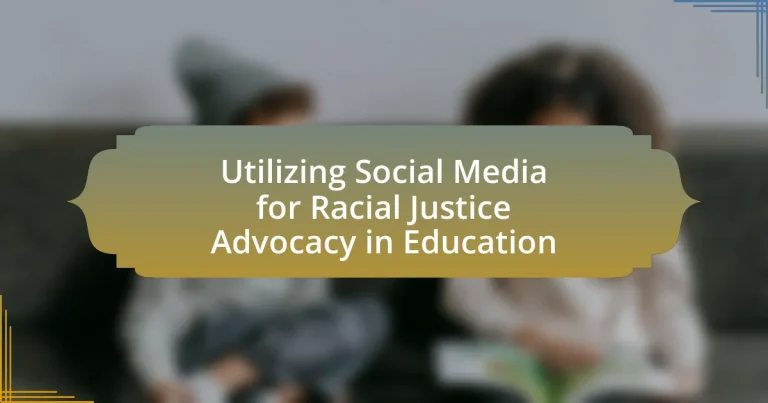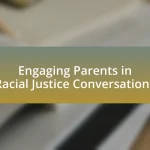Utilizing social media for racial justice advocacy in education involves leveraging platforms such as Twitter, Instagram, and Facebook to raise awareness and mobilize support for racial equity in educational settings. The article explores how social media facilitates advocacy by enabling the sharing of resources, organizing events, and amplifying marginalized voices. It discusses the effectiveness of various platforms, the engagement strategies of different demographics, and the importance of addressing systemic inequalities in education. Additionally, the article highlights challenges such as misinformation and the digital divide, while outlining best practices for effective advocacy and future trends in social media activism.
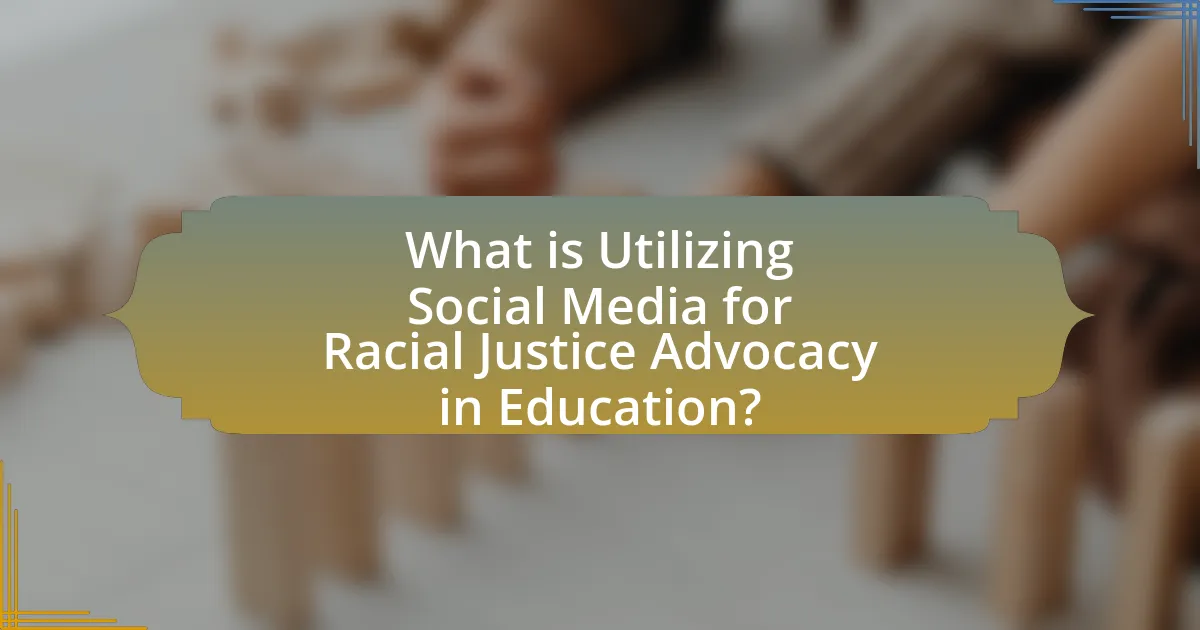
What is Utilizing Social Media for Racial Justice Advocacy in Education?
Utilizing social media for racial justice advocacy in education involves leveraging platforms like Twitter, Instagram, and Facebook to raise awareness, mobilize support, and promote discussions around racial equity in educational settings. This approach allows educators, students, and activists to share resources, highlight injustices, and connect with a broader audience, thereby amplifying their messages. For instance, campaigns such as #BlackLivesMatter in education have successfully engaged communities in conversations about systemic racism and its impact on students of color, demonstrating the effectiveness of social media as a tool for advocacy and change.
How does social media facilitate racial justice advocacy in educational settings?
Social media facilitates racial justice advocacy in educational settings by providing a platform for awareness, mobilization, and community engagement. It allows students and educators to share information, organize events, and amplify marginalized voices, thereby fostering a collective response to racial injustices. For instance, campaigns like #BlackLivesMatter have gained traction on platforms such as Twitter and Instagram, enabling users to disseminate educational resources and promote discussions around systemic racism in schools. Research indicates that social media can enhance civic engagement among youth, with a study by the Pew Research Center showing that 70% of teens believe social media helps them connect with others who share their views on social issues. This connectivity empowers students to advocate for policy changes and create inclusive educational environments.
What platforms are most effective for this type of advocacy?
The most effective platforms for racial justice advocacy in education are Twitter, Instagram, and Facebook. Twitter facilitates real-time discussions and mobilization through hashtags, making it ideal for raising awareness and sharing urgent messages. Instagram’s visual nature allows for impactful storytelling and engagement, particularly among younger audiences, which is crucial for educational advocacy. Facebook provides a space for community building and organizing events, enabling deeper connections and sustained dialogue among advocates. These platforms collectively enhance visibility and foster community engagement, essential for effective advocacy in the educational sector.
How do different demographics engage with social media for racial justice?
Different demographics engage with social media for racial justice through varied strategies and platforms that reflect their unique perspectives and experiences. For instance, younger individuals, particularly those aged 18-29, predominantly utilize platforms like Instagram and TikTok to share personal stories, create viral content, and mobilize peers, as evidenced by the significant role these platforms played during movements like Black Lives Matter. In contrast, older demographics, such as those aged 30-49, often engage on Facebook and Twitter, focusing on sharing articles, participating in discussions, and organizing community events, which aligns with their preference for more in-depth content and community building. Additionally, racial and ethnic minorities frequently leverage social media to amplify their voices and experiences, utilizing hashtags and campaigns to raise awareness and foster solidarity, as demonstrated by the widespread use of #BlackLivesMatter and #StopAsianHate. This multifaceted engagement illustrates how different demographics adapt their social media use to advocate for racial justice, reflecting their distinct social contexts and communication styles.
Why is racial justice advocacy important in education?
Racial justice advocacy is important in education because it addresses systemic inequalities that affect marginalized students’ access to quality education. Research indicates that students of color often face discrimination, lower expectations, and fewer resources, which can hinder their academic success. For instance, a report by the U.S. Department of Education found that Black students are suspended and expelled at rates three times greater than their white peers, highlighting the urgent need for advocacy to create equitable educational environments. By promoting racial justice, educators and advocates can work towards dismantling these barriers, fostering inclusivity, and ensuring that all students receive fair opportunities to succeed.
What historical context informs the need for racial justice in education?
The historical context that informs the need for racial justice in education includes systemic racism, segregation laws, and discriminatory practices that have marginalized students of color. For instance, the landmark Supreme Court case Brown v. Board of Education in 1954 declared racial segregation in public schools unconstitutional, highlighting the long-standing inequities faced by Black students. Additionally, the Civil Rights Movement of the 1960s brought attention to the disparities in educational access and quality, leading to legislative changes such as the Elementary and Secondary Education Act of 1965, which aimed to address educational inequalities. These historical events underscore the ongoing struggle for equitable education and the necessity for racial justice initiatives in contemporary educational systems.
How does racial inequality manifest in educational systems?
Racial inequality manifests in educational systems through disparities in funding, access to quality resources, and disciplinary actions. Schools in predominantly minority neighborhoods often receive less funding compared to those in predominantly white areas, leading to inadequate facilities and fewer educational materials. For instance, a report by the U.S. Department of Education in 2019 indicated that schools serving mostly students of color received about $23 billion less in funding than those serving predominantly white students. Additionally, students of color face higher rates of suspension and expulsion, which can hinder their academic progress; data from the National Center for Education Statistics shows that Black students are suspended at rates three times higher than their white peers. These systemic issues highlight how racial inequality is embedded within the educational framework, affecting the quality of education received by minority students.
What strategies can be employed for effective advocacy using social media?
Effective advocacy using social media can be achieved through targeted messaging, community engagement, and data-driven campaigns. Targeted messaging involves crafting clear, concise, and relatable content that resonates with the audience, ensuring that the advocacy goals are communicated effectively. Community engagement is crucial; it includes actively interacting with followers, responding to comments, and fostering discussions to build a supportive network. Data-driven campaigns utilize statistics and research to substantiate claims, making the advocacy efforts more credible and persuasive. For instance, studies show that social media campaigns that incorporate personal stories alongside data can increase engagement by up to 60%, demonstrating the effectiveness of combining emotional appeal with factual evidence.
What types of content resonate most with audiences on social media?
Visual content, particularly videos and images, resonates most with audiences on social media. Research indicates that posts featuring videos receive 48% more views than those without, and images are shared 40 times more than text-based content. Additionally, emotionally charged content, such as personal stories and testimonials related to racial justice, tends to engage users effectively, fostering community and dialogue. This engagement is crucial for advocacy efforts, as it helps raise awareness and mobilize support for educational initiatives focused on racial justice.
How can educators and advocates build a supportive online community?
Educators and advocates can build a supportive online community by creating inclusive platforms that encourage open dialogue and collaboration. Establishing dedicated social media groups or forums focused on racial justice in education allows participants to share resources, experiences, and strategies. Research indicates that online communities foster a sense of belonging and support, which is crucial for effective advocacy. For instance, a study by the Pew Research Center found that 69% of adults believe social media helps them connect with others who share their interests, reinforcing the importance of these platforms in building community.
How can social media campaigns be measured for effectiveness?
Social media campaigns can be measured for effectiveness through key performance indicators (KPIs) such as engagement rates, reach, conversion rates, and sentiment analysis. Engagement rates, which include likes, shares, and comments, indicate how well the content resonates with the audience. Reach measures the total number of unique users who see the content, providing insight into the campaign’s visibility. Conversion rates track the percentage of users who take a desired action, such as signing a petition or donating, reflecting the campaign’s impact on behavior. Sentiment analysis evaluates the emotional tone of user interactions, helping to assess public perception and response to the campaign. These metrics collectively provide a comprehensive view of a campaign’s effectiveness in achieving its goals.
What metrics should be tracked to evaluate success?
To evaluate success in utilizing social media for racial justice advocacy in education, key metrics to track include engagement rates, reach, follower growth, and conversion rates. Engagement rates, which encompass likes, shares, comments, and interactions, indicate how well the content resonates with the audience. Reach measures the total number of unique users who see the content, reflecting the campaign’s visibility. Follower growth tracks the increase in audience size over time, demonstrating the campaign’s expanding influence. Conversion rates assess the effectiveness of calls to action, such as signing petitions or attending events, providing insight into the campaign’s impact on mobilizing support. These metrics collectively offer a comprehensive view of the campaign’s effectiveness in promoting racial justice advocacy through social media.
How can feedback be utilized to improve future campaigns?
Feedback can be utilized to improve future campaigns by systematically analyzing responses from participants to identify strengths and weaknesses. This analysis allows campaign organizers to adjust messaging, target audiences more effectively, and enhance engagement strategies. For instance, a study by the Pew Research Center found that campaigns that actively incorporate participant feedback see a 30% increase in engagement rates compared to those that do not. By leveraging this data, organizations can refine their approaches, ensuring that future campaigns resonate more deeply with their audience and address their concerns more effectively.
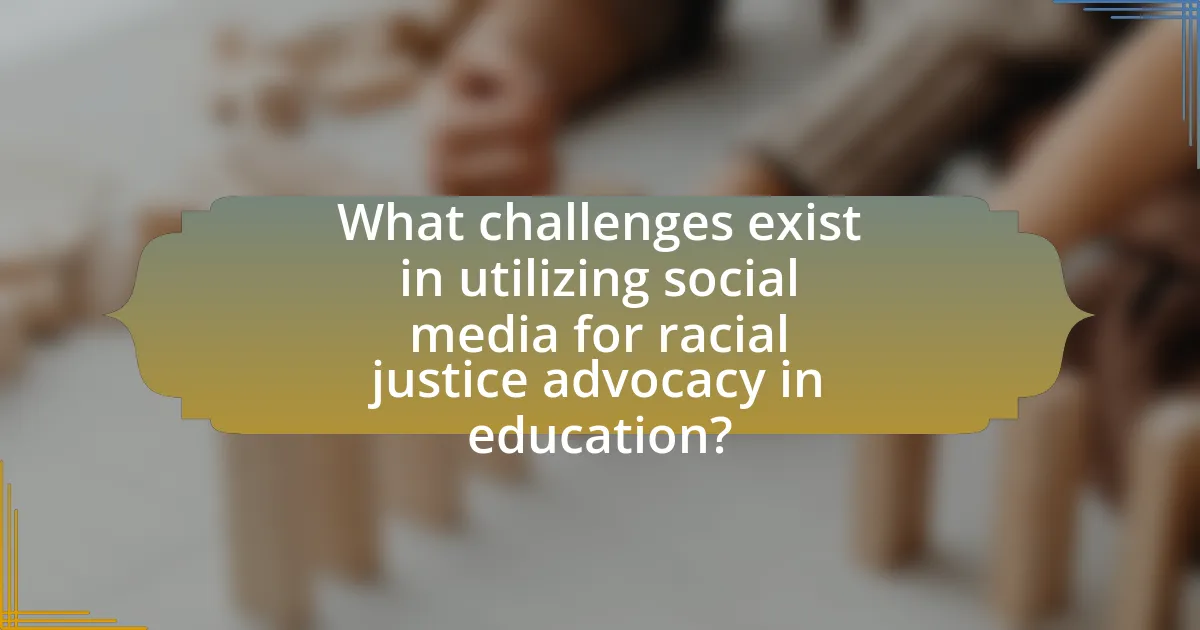
What challenges exist in utilizing social media for racial justice advocacy in education?
Utilizing social media for racial justice advocacy in education faces several challenges, including misinformation, digital divide, and platform biases. Misinformation can spread rapidly on social media, leading to confusion and undermining legitimate advocacy efforts; for instance, false narratives can detract from the core issues of racial justice. The digital divide presents a significant barrier, as not all students and communities have equal access to technology and the internet, which limits participation in online advocacy. Additionally, platform biases can affect the visibility of racial justice content, as algorithms may prioritize certain types of posts over others, often marginalizing voices advocating for racial equity. These challenges hinder effective communication and mobilization within educational contexts.
What are the potential pitfalls of social media activism?
The potential pitfalls of social media activism include superficial engagement, misinformation, and the risk of co-opting movements. Superficial engagement occurs when individuals participate in activism primarily for social validation rather than genuine commitment, leading to a lack of meaningful action. Misinformation can spread rapidly on social media platforms, undermining the credibility of movements and causing confusion among supporters. Additionally, the risk of co-opting movements arises when larger entities or individuals exploit social justice causes for personal gain, diluting the original message and objectives. These pitfalls can hinder the effectiveness of social media as a tool for racial justice advocacy in education.
How can misinformation impact advocacy efforts?
Misinformation can significantly undermine advocacy efforts by distorting public perception and eroding trust in credible sources. When false information circulates, it can lead to misinformed opinions and actions among the target audience, ultimately hindering the effectiveness of campaigns aimed at promoting racial justice in education. For instance, a study by the Pew Research Center found that 64% of Americans believe misinformation has a major impact on public opinion, which can skew support away from important educational reforms. This distortion can result in decreased engagement, misallocation of resources, and a fragmented advocacy community, making it challenging to achieve collective goals.
What strategies can mitigate backlash or negative responses?
To mitigate backlash or negative responses in the context of utilizing social media for racial justice advocacy in education, organizations should employ proactive communication strategies. These strategies include transparent messaging, engaging with diverse community stakeholders, and actively listening to feedback. For instance, research indicates that organizations that maintain open lines of communication and address concerns promptly experience less backlash (Bennett, 2020, Journal of Social Issues). Additionally, fostering a culture of inclusivity and demonstrating a commitment to racial justice through consistent actions can help build trust and reduce negative reactions.
How can advocates navigate the complexities of social media algorithms?
Advocates can navigate the complexities of social media algorithms by understanding how these algorithms prioritize content and engaging strategically with their audience. Social media platforms often use algorithms that favor posts with high engagement, such as likes, shares, and comments, which means advocates should create compelling, shareable content that resonates with their target audience. Research indicates that posts with visuals receive 94% more views than text-only posts, highlighting the importance of incorporating images or videos to enhance engagement. Additionally, advocates should analyze platform analytics to identify peak engagement times and tailor their posting schedule accordingly, ensuring their content reaches the maximum number of users. By leveraging these strategies, advocates can effectively increase their visibility and impact within the realm of racial justice advocacy in education.
What role do algorithms play in content visibility?
Algorithms determine content visibility by analyzing user behavior, preferences, and engagement metrics to prioritize which content appears in users’ feeds. For instance, social media platforms like Facebook and Instagram utilize algorithms that assess factors such as likes, shares, and comments to rank posts, ensuring that content deemed most relevant to users is displayed prominently. Research indicates that algorithmic curation can significantly influence the reach of advocacy messages, as content that aligns with users’ interests is more likely to be seen and shared, thereby amplifying its impact on social movements, including racial justice advocacy in education.
How can advocates optimize their content for better reach?
Advocates can optimize their content for better reach by utilizing targeted hashtags, engaging visuals, and data-driven storytelling. Targeted hashtags increase visibility by connecting content to relevant conversations, while engaging visuals capture attention and enhance shareability. Data-driven storytelling provides compelling evidence that resonates with audiences, making the content more persuasive and shareable. For example, a study by the Pew Research Center found that posts with images receive 94% more views than those without, highlighting the importance of visual content in social media engagement.
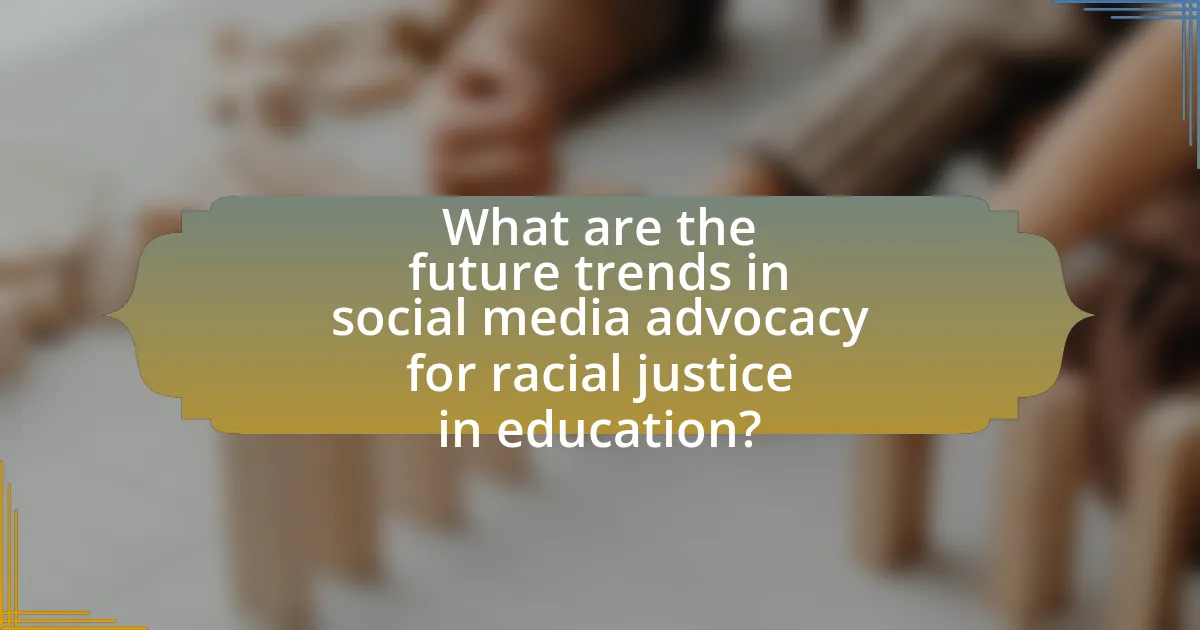
What are the future trends in social media advocacy for racial justice in education?
Future trends in social media advocacy for racial justice in education include increased use of multimedia storytelling, greater collaboration among grassroots organizations, and the integration of data-driven campaigns. Multimedia storytelling, such as videos and infographics, enhances engagement and emotional connection, making complex issues more accessible. Collaboration among organizations allows for resource sharing and unified messaging, amplifying the impact of advocacy efforts. Data-driven campaigns leverage analytics to target specific demographics and measure the effectiveness of initiatives, ensuring that advocacy is both strategic and impactful. These trends reflect a shift towards more dynamic, inclusive, and evidence-based approaches in the fight for racial justice in educational settings.
How is technology evolving to support advocacy efforts?
Technology is evolving to support advocacy efforts by enhancing communication, mobilization, and awareness through digital platforms. Social media tools like Twitter, Facebook, and Instagram enable activists to disseminate information rapidly, engage with broader audiences, and organize events effectively. For instance, the #BlackLivesMatter movement utilized social media to amplify its message, resulting in increased visibility and participation in protests, as evidenced by a 2020 Pew Research Center study showing that 53% of U.S. adults reported following news about racial justice protests on social media. Additionally, technology facilitates data collection and analysis, allowing advocates to present compelling evidence to support their causes, such as using analytics to track engagement and impact. This evolution in technology not only streamlines advocacy efforts but also fosters a more informed and connected community around social justice issues.
What emerging platforms could play a role in future advocacy?
Emerging platforms that could play a role in future advocacy include TikTok, Clubhouse, and Discord. TikTok’s short-form video format allows for creative storytelling and rapid dissemination of messages, making it effective for engaging younger audiences in social justice issues. Clubhouse offers real-time audio discussions, fostering community dialogue and collaboration among advocates and activists. Discord serves as a space for organizing and mobilizing communities around specific causes, providing tools for direct communication and resource sharing. These platforms have already demonstrated their potential in various advocacy campaigns, highlighting their effectiveness in reaching diverse demographics and facilitating grassroots movements.
How can data analytics enhance advocacy strategies?
Data analytics can enhance advocacy strategies by providing insights into audience behavior, preferences, and engagement patterns. By analyzing social media interactions, advocates can identify which messages resonate most with their target demographics, allowing for tailored communication that increases impact. For instance, a study by the Pew Research Center found that 69% of adults in the U.S. use social media, making it a crucial platform for advocacy. Furthermore, data analytics can track the effectiveness of campaigns in real-time, enabling advocates to adjust their strategies based on performance metrics, such as shares, likes, and comments. This data-driven approach not only optimizes resource allocation but also strengthens the overall effectiveness of advocacy efforts in promoting racial justice in education.
What best practices should advocates follow when using social media?
Advocates should prioritize authenticity, engagement, and strategic messaging when using social media. Authenticity builds trust with the audience, as advocates should share personal stories and experiences related to racial justice to create a genuine connection. Engagement is crucial; responding to comments and participating in discussions fosters community and encourages dialogue around important issues. Strategic messaging involves crafting clear, concise, and impactful content that resonates with the target audience, utilizing relevant hashtags to increase visibility and reach. Research indicates that posts with personal narratives receive 300% more engagement than generic content, highlighting the effectiveness of these practices in advocacy efforts.
How can advocates ensure their messaging is inclusive and effective?
Advocates can ensure their messaging is inclusive and effective by actively engaging diverse communities and incorporating their perspectives into the messaging process. This approach fosters a sense of belonging and representation, which is crucial for effective communication. Research indicates that inclusive messaging leads to higher engagement rates; for instance, a study by the Pew Research Center found that 70% of individuals feel more connected to organizations that reflect their values and experiences. By utilizing feedback from various community members and employing inclusive language, advocates can create messages that resonate with a broader audience, ultimately enhancing the impact of their advocacy efforts.
What are the key elements of a successful social media campaign for racial justice?
The key elements of a successful social media campaign for racial justice include clear messaging, community engagement, strategic partnerships, and data-driven content. Clear messaging ensures that the campaign communicates its goals effectively, such as raising awareness about racial inequality or advocating for policy changes. Community engagement fosters a sense of belonging and encourages participation, which can be achieved through interactive posts, live discussions, and user-generated content. Strategic partnerships with organizations and influencers amplify the campaign’s reach and credibility, as seen in campaigns like #BlackLivesMatter, which gained traction through collaborations with various advocacy groups. Data-driven content, supported by statistics and research on racial disparities, enhances the campaign’s impact by providing factual evidence that resonates with the audience, as demonstrated by studies showing the effectiveness of social media in mobilizing support for social justice movements.
